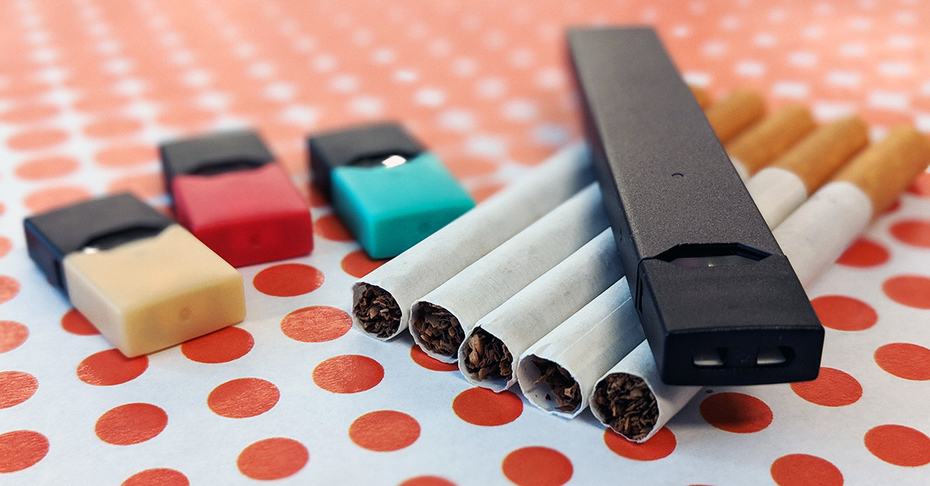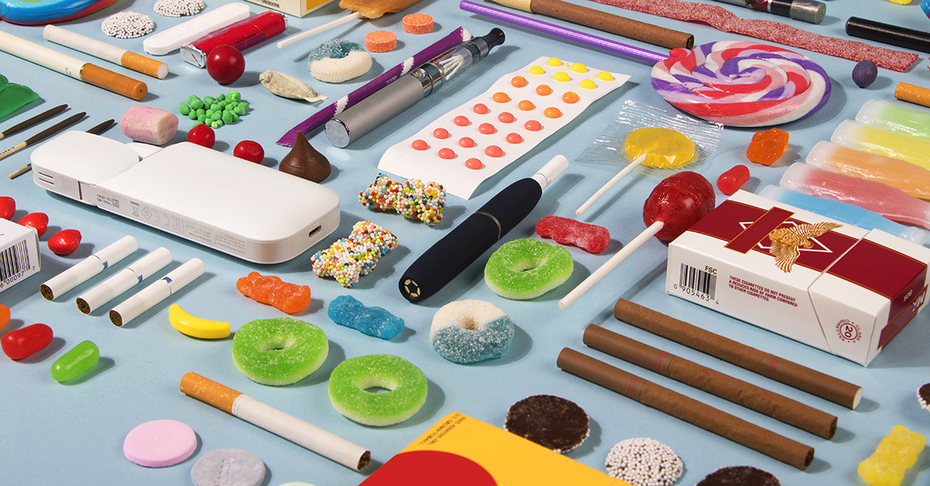
Surveying how the tobacco industry markets flavored products in five Midwest cities
Flavored tobacco products continue to fuel dangerous youth nicotine use. More than 80% of youth who have used tobacco report that they began with a flavored product. As the youth e-cigarette epidemic continues, more than eight in 10 (84.7%) of the 2.04 million high school and middle school students who vape use flavored e-cigarettes, according to the 2021 National Youth Tobacco Survey.
Flavored products, including menthol cigarettes and an array of flavored smokeless tobacco, cigars, little cigars, cigarillos, and many types of e-cigarettes, remain widely available. Flavors are a key way Big Tobacco targets youth and young adults, and retail-based marketing – from placing e-cigarettes next to toys and candy near a checkout counter, to discounting prices on flavored tobacco products and displaying product ads in a store – can encourage young customers to try these flavored tobacco products.
Exposure to tobacco marketing and advertising contributes to youth tobacco use initiation. Children and adolescents more frequently exposed to point-of-sale tobacco promotion have 1.6 times higher odds of having tried smoking and 1.3 times higher odds of being susceptible to future smoking compared to those less frequently exposed. Not only do the flavored products and their colorful packaging attract youth, but youth also perceive these flavored products as less harmful.

Sales restrictions on all flavored tobacco products, including all types of menthol products, are gaining momentum at the local and state level.
A survey of tobacco retailers in five cities, in three states, highlights how in-store marketing and particulars of place, inventory, price and other variables can make flavored tobacco products more accessible to youth. For the second time Truth Initiative has partnered with Counter Tools, an organization that specializes in helping state and local partners build healthier communities, on a study using store assessment questions that focus on the sale of flavored tobacco products. While our pilot study “Colorful and Close to Candy: Surveying how the tobacco industry markets flavored products in stores” examined marketing in stores in Ohio (Dayton and Cleveland) from 2018 to 2019, the most recent study spans from 2019 to 2020 and examines marketing in cities in Missouri (Columbia and Lee’s Summit) and Illinois (Evanston). Ohio and Missouri are part of a region Truth Initiative has deemed “Tobacco Nation.” A collection of U.S. states in the South and Midwest with smoking rates that exceed not only the national average of tobacco use but that of many countries with the highest smoking rates in the world, “Tobacco Nation” includes Alabama, Arkansas, Indiana, Kentucky, Louisiana, Michigan, Mississippi, Missouri, Ohio, Oklahoma, South Carolina, Tennessee, and West Virginia.
Given the broad availability of flavored tobacco products in all five cities surveyed in the first and second studies, policies that restrict the sale of flavored tobacco products are likely to benefit public health in these locales. Sales restrictions on all flavored tobacco products, including all types of menthol products, are gaining momentum at the local and state level. By the end of June 2021, 338 localities and three Native American tribes have placed some type of restriction on flavored tobacco products and, of those, 119 have comprehensive bans on menthol products, which are sometimes exempted from flavor policies. Findings from these store assessments demonstrate the need for local tobacco control policies that restrict all flavors.
PRODUCT AVAILABILITY ACROSS CITIES
Teams of trained community members in Dayton, Cleveland, Columbia, Lee’s Summit and Evanston looked at 288 retailers total, including convenience stores, grocery stores, mass merchandisers, tobacco shops and drug stores. Convenience stores, which are popular among young people, were the most common type of tobacco retailer in all five cities, with all retailers surveyed selling tobacco products. Flavored tobacco products were available for sale at all retailers surveyed in Dayton, Columbia, Lee’s Summit and Evanston. In Cleveland, they were available in 72 of the city’s 74 retailers surveyed.
Menthol cigarettes were available at all stores that sold cigarettes in Columbia and Lee’s Summit and available at all but two stores in each of the cities of Dayton, Cleveland, and Evanston. Availability of cigarettes with menthol capsules in the filter was markedly higher at tobacco retailers assessed in 2020 compared to those assess in 2018-2019.
Smokeless tobacco, popular in the Midwest, was available at more than two-thirds of stores in Dayton (68.8%), while available at only about a quarter of stores in Cleveland (25.7%). Flavored smokeless tobacco was available all stores that sold the products in Columbia and Lee’s Summit, and all but one in Evanston.
Cigarillos, little cigars, and blunts are very widely available in Cleveland (sold at 85.1% of stores). Cigarillos, little cigars, and blunts were similarly widely available in Columbia (82.4% of stores) and in Lee’s Summit (89.3% of stores). Though somewhat less available in Evanston (69.2% of stores), a large majority of tobacco retailers still sold them, and nearly all sold flavored versions.
E-cigarette products were more widely available in the cities where stores were assessed in 2020 than in those assessed in 2018-2019. Single disposable e-cigarettes were available in more than three-quarters of the stores in Evanston, compared to about a third of stores in Columbia and Lee’s Summit. While e-cigarette use has surged nationally among youth, the e-cigarette products were less available than expected in both Dayton and Cleveland. In Dayton, data collectors noted that e-cigarettes were less available in the inner city. Recent evidence from other studies is beginning to find disparities in the availability of e-cigarettes. A 2018 study conducted in New York City found that potentially less harmful products like smokeless tobacco and e-cigarettes were more likely to be sold in neighborhoods with more white and higher-income residents, potentially contributing to these results given the sociodemographic makeup of Cleveland. Similarly, a 2016 study in Milwaukee found the e-cigarettes were more available in predominately white areas of the city.

E-cigarette products were more widely available in the cities where stores were assessed in 2020 than in those assessed in 2018-2019.
LOCATION AND PRICE
Retail-based marketing is especially dangerous when it includes displaying tobacco ads in areas where youth frequent, such as near schools. When there are more tobacco retailers near schools, youth are more likely to experiment with smoking, and schools with more retailers within walking distance have higher smoking prevalence than schools with fewer retailers nearby.
In Cleveland, all 25 surveyed retailers located within 1,000 feet of schools had exterior advertisements for flavored tobacco products. In Dayton, 14 of 15; in Columbia, 5 of 11; in Lee’s Summit, 0 of 4; in Evanston, 1 of 9.
In Evanston and both cities in Ohio, prices were cheaper in neighborhoods with more youth, however this was not the case for the cities in Missouri. In 2018-2019, across products, a greater proportion of stores in Dayton offered price promotions than in Cleveland. Similarly, in 2020, across products, a greater proportion of stores in Columbia offered price promotions than in either Lee’s Summit or Evanston. This is in line with research showing that prices are often lower and discounts on tobacco products are steeper in lower-income areas, given that Columbia has a greater poverty rate than either Lee’s Summit or Evanston.
One of the largest differences between the cities located within Tobacco Nation and Evanston, the one participating city located outside of that region, is price. Prices for cigarettes in Evanston were nearly double those in Columbia, Lee’s Summit, Dayton, and Cleveland, and prices in Evanston were somewhat higher for e-cigarette products as well. This is unsurprising given the difference in cigarette excise taxes between Illinois ($2.98 per pack) and Missouri ($0.17 per pack), but is important given that raising prices is one of the most effective strategies for reducing tobacco use initiation, decreasing consumption, and increasing cessation.

Prices are often lower and discounts on tobacco products are steeper in lower-income areas.
THE VALUE OF STORE ASSESSMENTS AND GREATER LOCAL AWARENESS OF TOBACCO ISSUES
Store assessments have value beyond their extremely important data, in that they can make collectors of the data more aware of tobacco use issues in their localities, potentially motivating the data collectors to discuss these issues with members of their communities and become catalysts for policy changes. Given this opportunity, Counter Tools recommends strategic selection of data collectors. At Case Western Reserve University in Cleveland, coordinators recruited community residents and student volunteers. After collecting data from several stores, with issues of tobacco use on their minds, the recruited community residents hope to testify at a future city council meeting when Cleveland considers restrictions on flavored tobacco products.
Selecting locals to be data collectors may make store owners and clerks more comfortable during surveys, especially in cities with high segregation. An alternative could be data collectors who don’t match the demographics of the neighborhood. In Dayton and Columbia, staff members of their county health organization collected data, and in Lee’s Summit, staff of the local organization Lee’s Summit CARES collected. The group in Evanston wanted to include high school students, but the COVID-19 pandemic necessitated a change in plan.
A 2015 study of counties across the country, published in Tobacco Regulatory Science, showed that counties that had conducted retail tobacco assessments were more than six times as likely to have adopted point-of-sale policies than those that had not. All five cities in Truth Initiative and Counter Tools’ latest study can use its data to analyze how accessible flavored products are in their areas before and after implementations of any local or state policies.
To read the full report from Counter Tools and Truth Initiative and view the survey used for data collection, visit https://countertobacco.org/resources-tools/store-assessment-tools/fstars/
More in emerging tobacco products
Want support quitting? Join EX Program
By clicking JOIN, you agree to the Terms, Text Message Terms and Privacy Policy.
Msg&Data rates may apply; msgs are automated.



